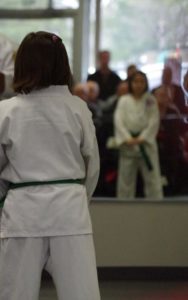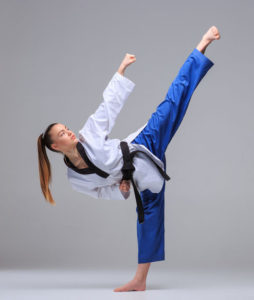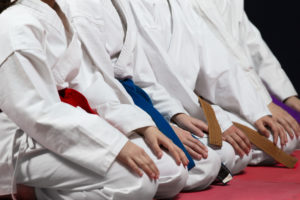Two years ago my, then ten-year-old, daughter and I started a journey together. We joined a local dojo (karate school). At the time my daughter was still looking for ‘her’ activity, and after trying both girl scouts and 4H as well as several intramural sports, I reached back into her early childhood when she had enjoyed participating in karate classes as a three and four year old. I was hoping to find an activity that we could share (much as her brother and father share camping and outings with Boy Scouts) that we would both find challenging and enjoyable—and maybe part of me had secretly always wanted to be a ninja.
A number of friends, family and even acquaintances have expressed surprise that this was the activity that my daughter and I settled on, or more specifically, that I was taking up karate as an adult. We tend to associate karate with classes of kids in white gis, or with high-intensity, high-level competitive martial artists, which we typically think of as male. But this is not a “kid only” or “male only” sport. According to the New York City-based research firm, Simmons Market Research, over 18.1 million Americans participated in karate or some other form of martial art at least once, and roughly 9.4 million were adults. The study also found that gender is pretty evenly split between men (52%) and women (48%). Karate is popular globally, with an estimated 50 to 100 million practitioners worldwide (Japan web and World Karate Federation, respectively), and was one of five new sports added to the 2020 Olympics in Tokyo.
 Martial Arts Improves Physical and Cognitive Performance in Youth
Martial Arts Improves Physical and Cognitive Performance in Youth
It is easy to find the reasons why people enroll their children in martial arts training. Participation in karate has been shown to improve physical performance in children and young adults as measured by such things as better coordination, reaction speed time, explosive leg strength and muscle endurance (1, 2). At the same time, children participating in karate also score better than their peers on executive functions, working memory and visual selective attention (1). Karate has also shown promise in helping with behavior issues by improving self-regulation and executive function (3).
When you look at the literature, though, it is clear that the benefits of martial arts such as karate are not limited to children and teens.
Martial Arts Improves Motor and Cognitive Skills in Adults
Physical activity effects not only muscles, bones and organs; there is growing evidence that these changes can also alter the functions and structure of the brain (4–6). In terms of choosing an activity, the nature of karate and other martial arts might be uniquely structured to optimize the benefits of physical activity on cognitive skills. This is because the practice of karate involves the whole body. It combines mid- to high-intensity cardiovascular activities including kicking, punching, stance and footwork exercises with the cognitive demands of learning long sequences of movements (called katas or forms). Katas can include kicks, punches, blocks and jumps performed while moving forward, backwards and to both sides. Kicks and punches are practiced both in the air and using contact resistance through hitting pads or shields. Finally, many karate programs include the practice of one-on-one sparring, which uses free-form combinations of kicks, punches, blocks and footwork in an elimination or points-based competition, and can help improve reaction times and visual acuity.
 For all of these reasons, the benefits of karate and similar martial arts have garnered interest as a possible physical activity intervention for older adults. Studies have looked at cognitive function (something know to decline as we age), physical strength (which can help counter the risk of falling) and overall wellbeing. A study focused on older adults (mean age 70) compared three groups, one practiced karate training (60 minutes, twice a week), one practiced general fitness exercises (gymnastics, running practice with balls and other hand-held devices, games and strength training), and the third group made no change to their daily routines. The results showed that 5 months of karate produced improved motor reactivity (how quickly they could react to a dropped rod) and enhanced attention (measuring divided attention ability by determining how fast they react to both visual and acoustic signals). Interestingly, this study continued the karate training group for an additional 5 months and found that this group showed a trend toward continued improvement (the authors note that because only this group was measured at the 10 month time point, they can only report the results as a trend) (7).
For all of these reasons, the benefits of karate and similar martial arts have garnered interest as a possible physical activity intervention for older adults. Studies have looked at cognitive function (something know to decline as we age), physical strength (which can help counter the risk of falling) and overall wellbeing. A study focused on older adults (mean age 70) compared three groups, one practiced karate training (60 minutes, twice a week), one practiced general fitness exercises (gymnastics, running practice with balls and other hand-held devices, games and strength training), and the third group made no change to their daily routines. The results showed that 5 months of karate produced improved motor reactivity (how quickly they could react to a dropped rod) and enhanced attention (measuring divided attention ability by determining how fast they react to both visual and acoustic signals). Interestingly, this study continued the karate training group for an additional 5 months and found that this group showed a trend toward continued improvement (the authors note that because only this group was measured at the 10 month time point, they can only report the results as a trend) (7).
A second study published in Research on Aging in 2016, compared the effects of karate training and mindfulness-based stress reduction (MBSR) in terms of emotional well-being and cognitive performance in a population of 52- to 81-year-old adults. This study was focused on evaluating training methods that could be effective in regulating late in life stressors such as declining health and mobility, memory, reasoning, and phonemic and semantic fluency, all of which can lead to depression as well as the accumulation of physiological stress indicators. The karate group trained in Shotokan karate where they learned attacking and defending as well as a kata (Heian Shodan), and emphasis was placed on cooperative training. The mindfulness group used techniques described by Kabat-Zinn in 2003 (9). Both groups met for 60 minutes twice a week for 8 weeks. The results showed a significant improvement in the karate group for perceived mental health (measured by questionnaire) and anxiety (measured by the Hospital Anxiety and Depression Scale; 10) as well as for cognitive processing speed (measured using the Zahlen-Verbindungs-Test; 11). The MBSR group showed a trend toward decreased stress (as measured by the Trier Inventory for Chronic Stress; 12).
Tai Chi Practice in Older Adults
If we expand martial arts to include ‘soft’ as well as ‘hard’ forms of practice, we can also evaluate the benefits of Tai Chi. Tai Chi is a Chinese martial art that combines deep breathing and relaxation techniques with slow continuous movements. This low-intensity martial art has been recognized as a potentially beneficial exercise intervention for the elderly (13) and those with mobility issues such as arthritis and other physical limitations (14).
A systemic review of studies investigating Tai Chi and cognitive ability found that Tai Chi did show potential for protective effects on healthy adult’s cognitive ability when compared to usual physical activities (15). The authors note that previous reviews had found that Tia Chi affected a small to moderate improvements in executive ability, language learning and memory, but that many of the reviewed studies did not compare effects of Tai Chi to other exercise routines.
Because Tai Chi is a slow, low impact form of exercise, it has been shown to counter act pain and improve functional status in adults with osteoarthritis (16) and rheumatoid arthritis (RA) (17, 18). It has also been shown to improve arterial stiffness and endothelial dysfunction elderly in women with RA (19), which suggests it could be useful in preventing cardiovascular disease in patients with an increased risk such as those with RA, a disease known to be associated with increased risk of cardiovascular disease.
Final Thoughts
Anecdotally, I have experienced many of the benefits described in these studies. I am stronger and more flexible. I have a better sense of balance. I have better muscle tone and I have lost weight. Overall, I feel better, and generally I am in a better mood. My, now twelve-year-old, daughter is stronger, more poised and self-confident. She has learned to work through frustration and persevere when learning a new technique or form. She has grown from doing just what she “had to do” to challenging herself to continue improving on her own—there have been a lot of karate combinations and forms practiced in our living room!
 Our Dojo has a twelve belt program: White>Gold>Orange>Green>Purple>Blue>Blue Stripe>Red>Red Stripe>Brown>Brown Stripe>Black. In December (2016) my daughter and I tested for our red belts, so while we have come a long way, we still have a way to go to reach our Black Belts. As we progress through the belts, we are faced with challenging new techniques and forms, but we also are always working towards mastery of old techniques. Unlike some sports were you can set concrete performance goals that can be measured (such as running an 8-minute mile or bench-pressing 200 pounds), progress in karate is measured both by learning new techniques and forms as well as continued mastery/improvement of former material.
Our Dojo has a twelve belt program: White>Gold>Orange>Green>Purple>Blue>Blue Stripe>Red>Red Stripe>Brown>Brown Stripe>Black. In December (2016) my daughter and I tested for our red belts, so while we have come a long way, we still have a way to go to reach our Black Belts. As we progress through the belts, we are faced with challenging new techniques and forms, but we also are always working towards mastery of old techniques. Unlike some sports were you can set concrete performance goals that can be measured (such as running an 8-minute mile or bench-pressing 200 pounds), progress in karate is measured both by learning new techniques and forms as well as continued mastery/improvement of former material.
One of my favorite things about karate is that it is an individual sport that you practice in a group setting. So even though we attend a class with 15–30 participants, our performance and progress is really only measured against ourselves (unless we are competing in a tournament). At the same time we enjoy the camaraderie and encouragement of our classmates, much as you would in a team sport. Most importantly, the benefits of practicing a martial art come at every belt level. So while I absolutely am focused on advancing to a black belt, the lifelong benefits of karate began the minute I bowed onto the floor for the first time.
References
- Alesi, M. et al. (2014) Muscles, Ligaments and Tendons J. 4, 114–120.
- Tsang, T.W. et al. (2010) J Obes.2010, pii: 672751. Epub 2010 Jun 7.
- Palermo, M.T. et al. (2006) Int J Offender Ther Comp Criminol. 50, 654–60.
- Chomitz, V.R. et al. (2009) Sch. Health. 79, 30–7.
- Smith, P.J. et al. (2010) Med. 72, 239–52.
- Price, A.E. et al. (2011) Aging Phys. Act. 19, 147–68.
- Witte, K. et al. (2016) Sport Health Sci. 5, 484–90.
- Jansen, P. et al. (2016) Research on Aging. Epub 2016 Sept 29.
- Kabat-Zinn, J. (2003) Psychol. Sci and Practice. 10, 144–156.
- Zigmond, A.S. and Snaith, R.P. (1983) Acta Psychiatrica Scandinavica 67, 361–70.
- Oswald, W.D. and Roth, E. (1987) Göttingen, Germany: Hogrefe Verlag fuer Psychologie.
- P. et al. (2004) Göttingen, Germany: Hogrefe.
- Woodward, T.W. (2009) Med. J.108, 40–3.
- Liu, Y.S. (2011) The Pshycological Intervention Effect Compared Taijiquan to Cognitive Counseling. Shanxi: Shanxi Medical University.
- Guohua Zheng, M.D. et al. (2015) J. Prev. Med. 49, 89–97.
- Chen, Y.W. et al. (2016) J. Sports Med. 50, 397–407.
- Wang, C. (2012) Rheumatol. Rep. 14, 598–603.
- Wang, C. (2008) Sport Sci. 52, 218–29.
- Shin, J-H. (2015) Arthritis Res. Ther. 17, 380–90.
Kelly Grooms
Latest posts by Kelly Grooms (see all)
- The Battle of Shiloh’s Angel’s Glow: Fact, Civil War Legend or Modern Myth? - July 11, 2024
- Mind Control, Mutilation and Death. The Fungal Fate That Lurks in Waiting for Emerging Periodical Cicadas - June 13, 2024
- Measles and Immunosuppression—When Getting Well Means You Can Still Get Sick - May 13, 2024


Thanks for this great post!
There are so many fantastic benefits of martial arts. Find out more here: http://www.fullcontactway.com/benefits-of-martial-arts/
Cheers
Jason